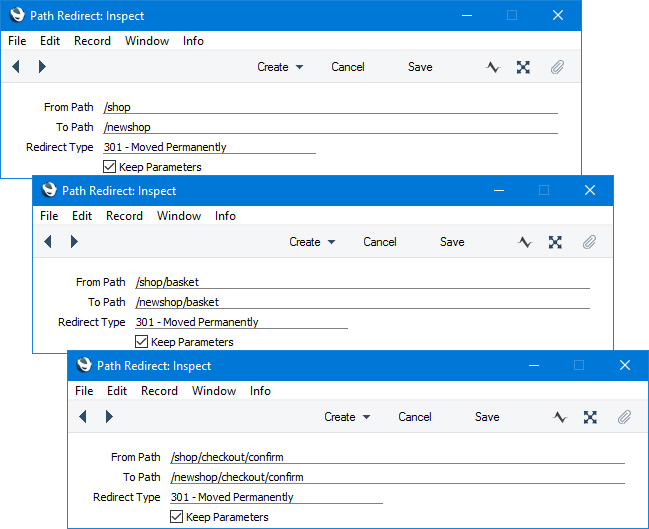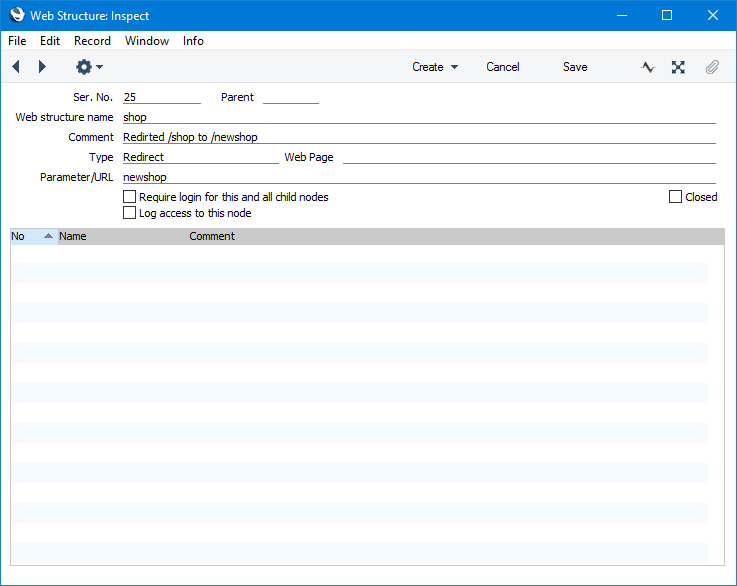Redirects
This section describes the Host Redirects setting, the Path Redirects setting and the following Structure Type:
All the settings and registers mentioned on this page are located in the Webshop and CMS module unless otherwise specified.
Host Redirects
The Host Redirects setting allows you to redirect domains to other domains. For example, you can redirect mywebsite.com to www.mywebsite.com, or myoldwebsite.com to mynewwebsite.com. It can be useful to continue to allow the use of the old URLs for a while until users become used to the new ones. Redirection also removes the need for duplicate content, which is beneficial both for maintenance and for search engine optimisation (SEO) reasons.
You can choose the redirect type that the server will use when handling the redirect requests. For the purposes of SEO it is recommended that you use redirect type 301 as this will preserve all existing indexing.
You should create separate records in the Host Redirects setting for each redirection.

- From Host
- Enter the name of the host from where browser users are to be redirected.
- To Host
- Enter the name of the host to where browser users are to be redirected.
- Redirect Type
- Paste Special
Choice of possible entries
- Using 'Paste Special', choose the redirect type that the server will use when handling the redirect requests. As previously mentioned, it is recommended that you always use redirect type 301
- Keep Path
- Select this option if you need to retain the full URL when redirecting e.g. if you need myoldwebsite.com/products/10101 to be redirected to mynewwebsite.com/products/10101. If you do not select this option, myoldwebsite.com/products/10101 will be redirected to mynewwebsite.com (if that is what is entered in the To Host field above).
- Keep Parameters
- In a similar manner, select this option if you need to retain any parameters that have been included in a URL when redirecting.
Path Redirects
The Path Redirects setting allows you to redirect individual pages to other pages. This will be useful if you have restructured your website and you want customers' bookmarks to old pages to take them to the equivalent new pages.
You should create separate records in the Path Redirects setting for each redirection. Include separate records for each sub-node as shown in the illustration if you feel direct links to sub-nodes are likely to have been bookmarked or if you have used them in your website.

- From Path
- Enter the path of the page from where browser users are to be redirected.
- To Path
- Enter the path of the new page to where browser users are to be redirected.
- Redirect Type
- Paste Special
Choice of possible entries
- Using 'Paste Special', choose the redirect type that the server will use when handling the redirect requests. As previously mentioned, it is recommended that you always use redirect type 301
- Keep Parameters
- Select this option if you need to retain any parameters that have been included in a URL when redirecting.
An alternative method to the Path Redirects setting is to use a Structure record in which the Type is "Redirect":

- Web structure name
- Enter the path of the page from where browser users are to be redirected.
- Parameter/URL
- Enter the path of the new page to where browser users are to be redirected.
You will still need to use Path Redirects for sub-nodes if you feel direct links to sub-nodes are likely to have been bookmarked.
All redirects from "Redirect" Structure records will be type 300 redirects. The Path Redirects setting allows you to use different redirect types.
---
Go back to:
